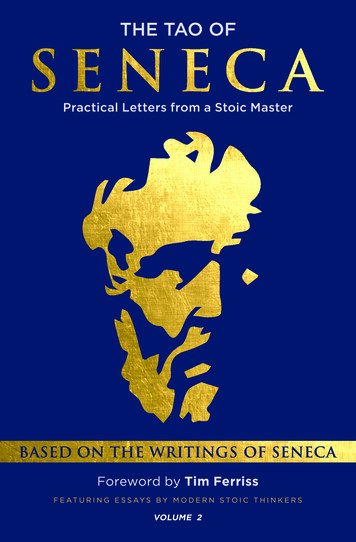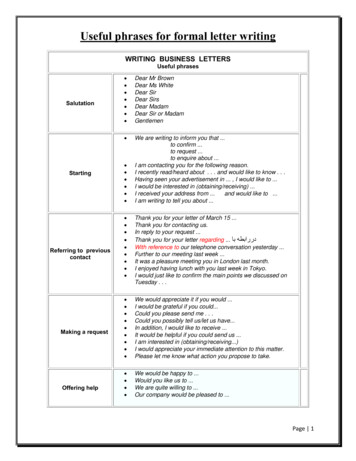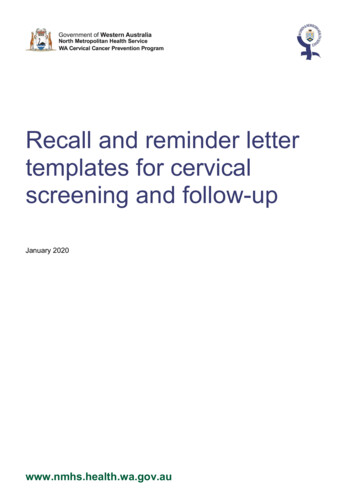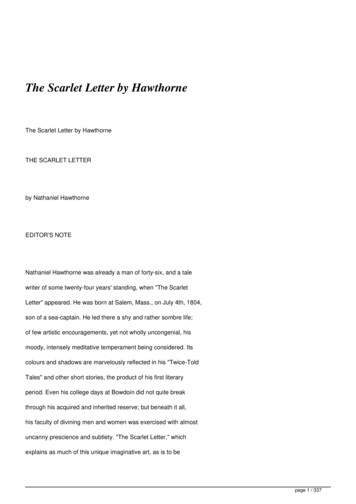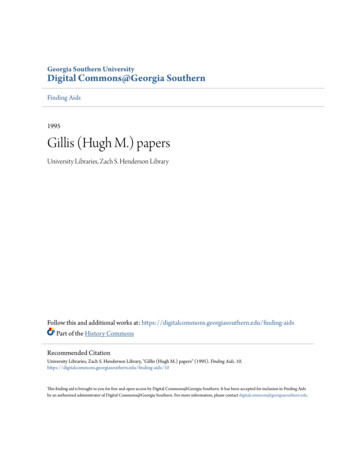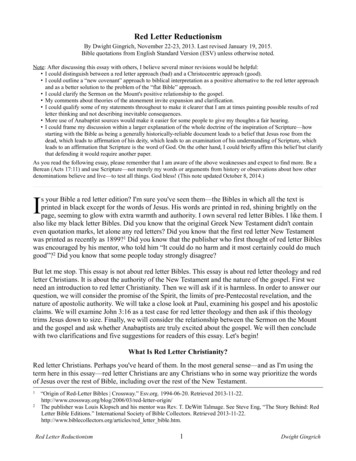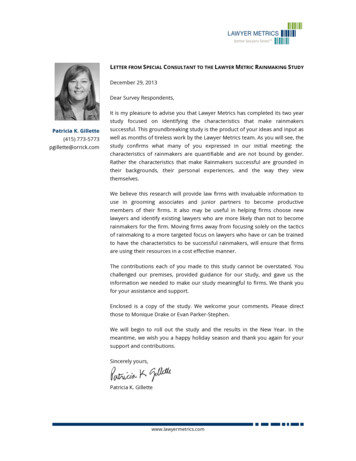
Transcription
LETTER FROM SPECIAL CONSULTANT TO THE LAWYER METRIC RAINMAKING STUDYDecember 29, 2013Dear Survey Respondents,It is my pleasure to advise you that Lawyer Metrics has completed its two yearstudy focused on identifying the characteristics that make rainmakersPatricia K. Gillette(415) 773-5773pgillette@orrick.comsuccessful. This groundbreaking study is the product of your ideas and input aswell as months of tireless work by the Lawyer Metrics team. As you will see, thestudy confirms what many of you expressed in our initial meeting: thecharacteristics of rainmakers are quantifiable and are not bound by gender.Rather the characteristics that make Rainmakers successful are grounded intheir backgrounds, their personal experiences, and the way they viewthemselves.We believe this research will provide law firms with invaluable information touse in grooming associates and junior partners to become productivemembers of their firms. It also may be useful in helping firms choose newlawyers and identify existing lawyers who are more likely than not to becomerainmakers for the firm. Moving firms away from focusing solely on the tacticsof rainmaking to a more targeted focus on lawyers who have or can be trainedto have the characteristics to be successful rainmakers, will ensure that firmsare using their resources in a cost effective manner.The contributions each of you made to this study cannot be overstated. Youchallenged our premises, provided guidance for our study, and gave us theinformation we needed to make our study meaningful to firms. We thank youfor your assistance and support.Enclosed is a copy of the study. We welcome your comments. Please directthose to Monique Drake or Evan Parker-Stephen.We will begin to roll out the study and the results in the New Year. In themeantime, we wish you a happy holiday season and thank you again for yoursupport and contributions.Sincerely yours,Patricia K. Gillettewww.lawyermetrics.com
The Rainmaking Study iiThe Rainmaking STudyHow Lawyers’ PersonaLity traits and BeHaviorsdrive successfuL cLient deveLoPmentmonique drake and evan Parker-stePHen, PHd
Lawyer Metrics iiiWho Is aRainmaker?Rainmakers are a diverse group, and few will conform in every respect to aStudy reveals that Rainmakers are more likely than others to have somecombination of these qualities:time, Rainmakers focus on larger issues and do not become overwhelmedteam through delegation and empowerment and are comfortable lettingteam members take on increasing responsibilities, listening to their views,than other lawyers to question established methods, to interpret systemsmakers, and Rainmakers are less likely to have attended an elite college orFemale and male Rainmakers are more alike than different in traits andtheir male colleagues to enjoy concentrating on something for a long timeing client problems and building a substantial law practice may help satisfyBased on our research, lawyers who possess the traits and attributes described above are more likely, as a statistical matter, to develop a strong
The Rainmaking Study ivContentsI. overvIew . . . . . . . . . . . . . . . . . . . . . . . . . . . . . . . . . . . . . . . .1II. researCh Methodology . . . . . . . . . . . . . . . . . . . . . . . . . . . . .233Understanding Biographical Factors4III. a seleCtIon of study fIndIngs . . . . . . . . . . . . . . . . . . . . . . . .55568b) Looking Beyond the Matter at Hand991010121314141415Iv. ConClusIon . . . . . . . . . . . . . . . . . . . . . . . . . . . . . . . . . . . . . 16
Lawyer Metrics 1I. overvIewof rainmaking superstars to the broader group of partners wholeaders and corporate counsel, Lawyer Metrics employed qualitative and quantitative methods to identify the personality traits andmanagement behaviors that distinguish Rainmakers from otherioral factors that are prominent among lawyers, the RainmakingStudy breaks new ground by analyzing how these factors correlate1Lawyer Metrics draws on performanceand over 80 interviews with Rainmakers and non-Rainmakers (orlawyers’ backgrounds, work styles, motivations, and client devel-1See, e.g.-for Successful Lawyering” SocialScience Research Network (2008);Foster, Larry Richard, Lisa Rohrer,and Mark Sirkin, “UnderstandingpredictToward that end, this Study uses assessments and interview datato identify the skills, traits, and behaviors that truly distinguishwho possess an intense drive to engage in their work, as measured-
The Rainmaking Study 2-also show a greater willingness to take risks, as indicated by theirreadiness to “put themselves out there” to develop business andmore alike than they are different, though one aspect of their homewho have a spouse or domestic partner and children, the spousesof women Rainmakers far more often work outside the home whilecertain distinguishing Rainmaker traits present themselves in practice, and whether certain biographical factors such as school pediFinally, upon reading the following pages, the reader is sure to ask,First, the evidence suggests that Rainmakers differ from other lawsize and breadth of our sample, we believe that the behavioral2Second, many of the rainmaking abilities studied here can belawyers to understand their own attitudes about work and clientII. researCh MethodologyThe Study incorporated three research tools to identify the distinguishing traits and behaviors of Rainmakers:This study provides some of theselection criteria needed for a struc2Kahneman, Thinking, Fast and Slow
Lawyer Metrics 3A. The Survey: Gauging PerceptionsThe Survey asked respondents to rank individual traits and toB. The Assessments: Measuring Personality TraitsThe Study measured the traits and behavioral tendencies of Rainas high or low-performers using a grading system that emphasizestendencies that are associated with successful workplace perforcomprised of 17 separate components that are grouped togetherunder three broad categories of motivation: (1) self-assurance; (2)managing change; (2) planning and organization; (3) interperson-
The Rainmaking Study 43fort, lawyers can continue to boost their strengths and better mana person’s attitudes and mindset and thus how they are likely to-The Study incorporates statistical models that relate lawyers’ mea-ments are similar in at least one important respect: they were normedagainst a sample of business and3result, average scores on the assess-typical levels within the populationof skilled professionals.The statistical models are Bayesian multilevel logistic regressions,which generate inferences about how the predictors—in this case,the scores on the assessments factors—affect the likelihood that aFor the sake of both conceptualclarity and parsimony, we estimated44a particular trait are made while assuming all else is equalmodels thereby allow us to see not only whether a particular traitholding all else equal, a higheriate regression allows us to identify which of these many factors-C. The Interviews: Presentation of Traits and Behaviors and Understanding Biographical FactorsTo understand how Rainmaker traits and behaviors present them-said, we arrive at the same conclusions about what makes Rainmakers distinctive when we estimatea “pooled assessment” regression,which is to say, a single regressionand
Lawyer Metrics 5selves in practice, Lawyer Metrics interviewed 86 partners acrosshavioral tendencies of Rainmakers and enhance what we learn5choices, attitudes, and behaviors relating to work and client development, including their paths to achieving professional successand watershed moments and decisions in their careers and per-5-traits and behaviors that bear onthose measured using the assess-The interview participants included 62 Rainmakers and 24 Cli-66shared with us the value of theirbooks of business, most did; basedon that data, the interviewed Rainmakers averaged over 4 million inIII. a seleCtIon of study fIndIngsA. The Survey: Top Perceived Rainmaker Traitsperts perceive Rainmakers to be, ambitious, and charismatic, and also to be resilient risk-takersas focused closely on their clients’ business concerns and issues,relationship-building, though successfulteam playersbutes in planning, integrity, and quality focus.B. The Assessments and Interviews: Top Distinguishing Rainmaker Personality Traits and BehaviorsRainmakers earn higher overall scores on assessments of their perreports the means of the overall scores for Rainmakers and Client
The Rainmaking Study 6Looking beneath these summary scores, certain traits and behavwhich higher scores produce athe partner is a RainmakerFigure 1. Rainmaker (RM) andClient Service Partner (CSP) MeanOverall Scores on the AMI andMDQ. Left and right endpointsrepresent the 25th and 75th percentile scores, respectively.AMIMean 889.10RMlow-scoring partners to be Rainmakers:Mean 867.73Engagement (AMI) (a desire to be regularly engaged inan activity, usually work-related)CSP850GroupDominance (AMI)900950MDQMean 116.68Motivating Others (MDQ) (an ability to manage a teamthrough delegation and empowerment, while also trusting people to take on increasing responsibilities, listening to their views, and encouraging them to act on theirown)RMMean 111.78CSP100Risk Taking (MDQ) (a willingness to question established methods, supplying a break with the past and being prepared to bend the rules to achieve higher performance)110120Overall Score130hood of being a Rainmaker, if a partner in our sample scored at the75th percentile on all four of these dimensions—admittedly, this isan atypical partner—he or she was almost 70% more likely to bea Rainmaker than a partner who scored at the 25th percentile on77matter while holding all else equal,it was necessary to derive this resultusing the “pooled assessments” re-1. Engagement and Dominancea high priority on work and are uncomfortable when they havedimension may be “workaholics,” neglecting aspects of their per-
Lawyer Metrics 788ment Score increases the probability that a lawyer in the sample isassumingaverage performance for all of the other AMI traits (what we mean91.0derive from the assessment industryManagement Development Questionnaire.The data are scaled in such a waythat an assessment score equal tozero represents the mean of that9Prob. 0.90Probability of Being a Rainmaker 0.5 Prob. 0.400.0ly Increases the Probability of Being a Rainmaker.0Engagement Score1dard deviations above the mean, and a second partner has a scorethat is two standard deviations below this mean (these values areequal to 1 and -1 in Figure 2), the high-scoring partner is 50%important to consider that it is based on a simulation that assumesthe two partners have average scores on all of the remaining 16equally skilled, the one who is far more engaged is also far more1010-a comparison where one lawyer wasat the 75th percentile and the second was at the 25th percentile forall four indicators, whereas here wefocus on plus or minus two standarddeviations (the latter covers 95% ofthe observed values in the data) forof a single variable, it is customary
The Rainmaking Study 8to consider the range of observed1.0Prob. 0.86Probability of Being a Rainmaker 0.5earlier contrast focused on four indicatorstremes on all four of the assessmentfactors, and a comparison based ontwo standard deviations in that casewould return a statistically valid but Prob. 0.480.00Dominance Score1Increases the Probability of Beinga Rainmaker.Throughout the interviews, Rainmakers discussed the personalitytraits and behaviors that they credit most for their client develop-a) Internal DriveThe interviewed partners all share a strong work ethic, but higherwhat drives them to work hard, whatmotivates them to develop their own clients, and even what drew1111shared with us their hours, Rainmakers averaged only slightly higher billable hours than Client Serviceabout 40% higher client develop-order to advance, Rainmakers are strongly self-motivated andcommitted to succeed in winning clients as a way not to be be-a willingness to point to outside factors that might impede their
Lawyer Metrics 9of motivation and career satisfaction during the interview processb) Looking Beyond the Matter at Handmatter, they recognize that everyone they are in contact with isents’ businesses and personal lives and to develop these relationships not only through hard work on the issue the client presents,ner of problems, including helping a client’s child facing an indelin practical ways, including by introducing clients to other peoplehelp, and they do whatever they have to do, even at great personalwillingly forego sleep, personal time, and vacations to develop thec) Engagement in Personal Relationshipswith quite a few noting that they “love people” and are “fascinatinteractions, whether it is sharing a meal with a client, sendingpersonalized birthday gifts to the client’s children, selecting a special book as a gift rather than sending mass-produced cards forthe holidays, being reachable on the telephone, or visiting a clientown availability and responsiveness as a function of their indispensability to the client personally
The Rainmaking Study 10d) Solving Practical Business Problems, Not Answering Abstract Intellectual Questionspractical andbusiness challengestheir strengths, Rainmakers tended to describe their decisivenesspecially male Rainmakers) frequently described enjoying businessour sample are less likely to be Rainmakers when they received highless likely to be a Rainmaker than a low-scoring partner; a partner12tailing the complete results for the12from developing clients, some of the Rainmakers suggested thatThese lawyers may hesitate to show the leadership and decisive-2. Teamwork vs. Motivating OthersRainmakers further distinguish themselves in how they work withlight on Rainmakers’ approaches to Teamwork and MotivatingSurvey respondents saw teamwork as a distinguishing Client Ser-
Lawyer Metrics 11vice Partnerbut not by very much; and while our model indicates that scoringhighly on Teamwork makes it about 20% less likely that a subjectis a Rainmaker, there is some statistical uncertainty in this inferThe uncertainty may be due in part to the different ways thatan important element of their client development, but the Rainof working with theirclientsand motivation they feel by listening to and working with theirclients (i.e., as if on a team with them) to solve their client’s largeradvisors” focused on their clients’ big picture needs, not simply as-to manage a team through delegation and empowerment, whilealso trusting people to take on increasing responsibilities, listeningmanage a team and motivate others by offering increasing respon1345% more likely to be a Rainmaker than a lawyer who scores lowsponsibility to team members prob13go beyond client development andthe obvious improvement in leverbelieved they were assigned increasing responsibility when ready had
The Rainmaking Study 121.0Prob. 0.86Probability of Being a Rainmaker 0.5 Prob. 0.41Figure 4. Capacity for MotivatingProbability of Being a Rainmaker.0.00Motivating Others Score13. Risk-Takinga person’s willingness to question established methods, supplyinga break with the past and being prepared to challenge the rules toThe results do not necessarily reveal which traits and behaviorsRainmakers have a lot or a little of, but rather which of these fac-
Lawyer Metrics 131.0Prob. 0.84Probability of Being a Rainmaker 0.5 Prob. 0.450.0Figure 5. Risk Taking Behaviorbility of Being a Rainmaker.0Risk Taking Score1see lawyers who do not generate new business as differing fromthemselves largely in terms of lower motivation and effort as wellthey demonstrate a far greater willingness than do Client Service-4. Differences Between Female and Male Rainmakers-makers did score higher than their male counterparts at statisticalability to concentrate on something for a long time without being-
The Rainmaking Study 1414The higher Flow scores for female Rainmakers may be connected-Flow is an area of research intional information on Flow and itsrelationship to work and creativity,14-why female Rainmakers are able to develop a substantial clientfollowing despite being much less likely to have the support of aC. Biographical Trendsfamily background, school pedigree, and adult family situation,151. Childhood Family Backgroundchological development, birth order is popularly hypothesized to-an oldest or only child, and the difference is not statistically sig16plored in the Study to shed lighton the different, real-world circumstances that many lawyers may facepreting the assessment results, andnot to suggest that such inquiry isever appropriate in hiring or pro1516For all biographical factors, statis-leged upbringings may have a better grip on the skills that supportSimilarly, both Rainmakers and high-performing Client Serviceners to have had a parent (generally the father) who worked as aFigure 6. The Percentage of Rainmakers and Client Service Partners Who Paid for College All orMostly Themselves.32%Percent Paid for Collegethemselves or mostly themselves, whether by work, scholarships,or loans, and this difference between the two groups, which is il-30208%102. School PedigreeFurther suggesting that prestigious pedigree does not necessarily0RainmakerClient Service PartnerGroup
Lawyer Metrics 15enhance client development success, the Rainmakers interviewedgraduated from a currently ranked top-ten law school or under-3. Current Family Situation(including a domestic partner) and children (and the vast majorityRainmakers were more or less likely than those of Client Service-ships) were somewhat less likelyners to have had a stay-at-home spouse while they also had youngless likely than female Client Service Partners and alsoless likely than male Rainmakers to have had a stay-at-home spouseRainmakers, who were more likely than all other groups (male orover tentimes as likely as female Rainmakers to have had a stay-at-hometerviewees across all of the groups acknowledged the support thatadded challenges that many women face in maintaining demand-
The Rainmaking Study 16Gender6062%FemaleMale41%4029%20Figure 7. The Prevalence of aStay-at-Home Spouse or PartnerAmong Married Rainmakers andClient Service Partners By Gender.5%0RainmakerGroupClient Service PartnerIv. ConClusIondevelop partners with the skills to sustain and grow client relationthat distinguish these partners and the ways that their attributesMeaningful development of these traits requires connecting thisgeneral understanding to particular personal considerations and(1) self-awareness and understanding of the lawyer’s own qualidertaking personalized and individually-focused development thatFor more information about the Study and how its results might beused to develop individually-guided programs that help to identifyplease contact Lawyer Metrics.
Lawyer Metrics 17appendIxThe results described in the Rainmaking Study highlight the mostelaborate on the traits and behaviors that were tested as potential-a high rainmaking probability, and a low score produces a lowrainmaking probability, this trait is considered important to idenestimated make it possible to calculate the probability differences,are large and have an uncertainty estimate (represented by thegray line) that does not include zeroes (dots) along with a measure of uncertainty for each estimatepectations between a lawyer whose trait score is high (at 1) andterms of the relatively unchangeable personality traits, only these
The Rainmaking Study 18Figure A1. The Probability Difference of Being a RainmakerWith a High Versus a Low AMI Trait Score. Engagement Dominance Flexibility Internality FlowPersistence Independence AMI TraitPrefer Difficult TasksStatus Orientation Self Control Goal Setting Compensatory EffortFearlessness Competitiveness Confidence in Success Pride in Productivity Eagerness to Learn 0.000.250.50Change in Rainmaking Probability (90% C.I.)0.75
Lawyer Metrics 19lawyer whose trait score is high (at 1) and a lawyer whose trait-suggests that Rainmakers are relatively less likely to seek feedbackare not necessarily inconsistent with their lower emphasis on concates that, although Rainmakers are driven to work long hours,
The Rainmaking Study 20Figure A2. The Probability Difference of Being a RainmakerWith a High Versus a Low MDQ Behavior Score. Motivating Others Risk Taking Oral CommunicationAuthority Presence Achievement Orientation Developing People Relationships MDQ BehaviorFlexibility/Adaptability Business AwarenessPlanning Innovation ResilienceInitiative Decision Making Analytical Thinking Client Focus TeamworkSensitivity Quality Focus Learning Orientation 0.00.4Change in Rainmaking Probability (90% C.I.)
Lawyer Metrics 21MONIQUE DRAKE-Denver, CO-Director, Lawyer DeveLopmentT: ersity of Chicago, J.D.University of California, Berkeley, B.S.Mechanical Engineeringto develop the traits that, based on Lawyer Metrics’ research,are most likely to enhance their practices and lead to successBefore joining Lawyer Metrics, Monique was an equity part-in 1993 from the University of Chicago, where she servedScience degree with honors in mechanical engineering from
The Rainmaking Study 22EVAN PARKER-STEPHEN-New York, NYdevelopment that enables lawyers to identify their strengthsDirector, anaLyticsT: , placing particular emphasis on the visual displays ofUniversity of North Carolina, Ph.D.Political ScienceUniversity of North Carolina, M.A.Political Sciencescale human data to study how beliefs and preferences getUniversity of Wisconsin, B.A.Political Science-
Lawyer Metrics 23AcknowledgementsThe authors gratefully acknowledge thegenerous assistance and valuable insightsprovided by the following individuals whohelped make this study possible:Ramla FarzadBill HendersonCaren Ulrich StacyChristopher Zorn
certain distinguishing Rainmaker traits present themselves in prac-tice, and whether certain biographical factors such as school pedi-HSFF NBZ DPSSFMBUF XJUI SBJONBLJOH Finally, upon reading the following pages, the reader is sure to ask, i8IBU EP XF EP XJUI UIJT w First, th

